Yukgaejang is a hearty, spicy beef soup made with shredded beef, lots of scallions and other vegetables. Perfect soup for cold days ahead!
Yukgaejang (육개장) is a hearty, spicy beef soup that’s highly popular in Korea. Made with shredded beef, lots of scallions (pa, 파) and other vegetables such as gosari (fernbrake fiddleheads), beansprouts, and mushrooms, this is a substantial soup that has a great depth of flavor.
You won’t need anything other than a bowl of rice for a completely satisfying meal on a cold winter day. In Korea, yukgaejang is also popular as nourishing soup that helps fight the summer heat.
As we do with many Korean soups, we often enjoy this soup with some rice mixed in. Some people prefer to keep the rice and soup separately while eating. What’s your preference?
Which cut of beef to use
Beef brisket (yangjimeori, 양지머리) is the typical cut for this soup and many other Korean soups. It’s a flavorful, tough cut of meat that’s great for making broth. When properly boiled, the meat turns pull-apart tender, making it ideal for this soup. You can also use flank steak (chimasal, 치마살) or shank meat (satae, 사태).
If chicken is used instead, the soup is then called dakgaejang (닭개장).
Vegetables
If you want to use only one vegetable for this soup, it should be scallions. Lots of them! After the beef, this is the most important ingredient for this soup. In Korea, the large variety green onions, called daepa (대파), are used for soups. No, they are not the same as leeks. Daepa is packed with unique sweet oniony flavor. It really elevates the tastes of soups!
Luckily, daepa now is available at Korean markets around here, especially during fall and winter.
There are other similar beef soups in Korea, but gosari (fernbrake fiddleheads) is unique in this soup. You can buy dried gosari (고사리) at any Korean market and rehydrateby a combination of soaking and boiling in water. Look for the ones with short, thin stems.
Besides adding soft, chewy texture to the dish, gosari imparts a deep, earthy flavor to the soup. A bag of dried gosari can last for a long time in your pantry, and you can also use to make gosari namul side dish, which is great in bibimbap(비빔밥).
Seasoning
Sesame oil is essential, and it’s typically infused with gochugaru (Korean red chili pepper flakes) for a chili oil effect. Simply heat the oil and mix with the gochugaru. For added layers of flavor, I usually add very small amounts of gochujang (Korean red chili pepper paste) and doenjang (Korean fermented soybean paste). But, absolutely optional! This yukgaejang recipe is not fiery hot. Adjust the heat level according to your taste.
Variations
If you want your soup to be extra rich, you can also boil some beef bones (such as neck bones) with the meat. Or, I sometimes add some pre-made seolleongtang broth (aka milky bone broth or sagol yuksu) to boil the meat because I usually have some in my freezer. You can also use store-bought milky beef bone broth, which is usually labeled as sagol yuksu (사골육수) or sagol gomtang (사골곰탕).
You can also use anchovy broth or dashima broth to boil the beef to add extra flavors to the resulting broth.
I usually drizzle lightly beaten eggs over the soup at the end of cooking. Some people prefer thin egg omelette garnish (jidan, 지단). You can skip the eggs if you want.
Noodles are also a great addition! Dangmyeon (당면), sweet potato starch noodles (aka japchae noodles), is typical for this soup.
Instant Pot yukgaejang
Lately, I’ve been using my Instant Pot to make this dish. It really is much quicker to cook a tough cut of meat, and I love how tender and moist the beef turns out.
Simply add the meat, onion, and optional radish to the Instant Pot along with water. You will need much less water because it doesn’t evaporate in the Instant Pot. I use about 10 cups for this recipe.
Then, cook on Manual High for 30 minutes. When it’s done cooking, release the pressure after 10 minutes. Remove the meat, and strain the broth. Follow the rest of the recipe, and use the Sauté function to finish up.
More soup recipes
For more Korean cooking inspirations, follow along on YouTube, Pinterest, Twitter, Facebook, and Instagram.
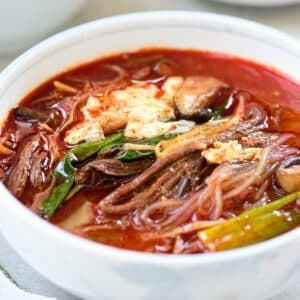
Ingredients
- 1 ounce dried gosari, 고사리 (fernbrakes) - about 1 cup rehydrated
- 1 pound beef brisket, 양지머리 (or flank steak or shank meat)
- 1/2 onion (do not cut off the stem)
- 8 ounces Korean radish (mu, 무), cut into big chunks - optional
- 8 ounces bean sprouts (sukju, 숙주)
- 3 dry shiitake mushrooms, soaked (or 2 ounces fresh shiitake or oyster mushrooms)
- 2 - 3 bunches scallions (or 2 or 3 stalks of Korean daepa (large variety scallion) 2 or 3 stalks of Korean daepa (large variety scallion)
Seasonings
- 2 tablespoons sesame oil
- 2 tablespoons gochugaru, 고추가루 (red chili pepper flakes) - 2.5 to 3 TB for spicier soup
- 1 tablespoon minced garlic
- 2 tablespoons guk ganjang, 국간장 (soup soy sauce), divided
- 1 teaspoon gochujang, 고추장 (red chili pepper paste) - optional
- 1 teaspoon doenjang, 된장 (soybean paste) - optional
- salt and pepper
Optional additions
- 2 eggs lightly beaten
- 3 ounces dangmyeon (당면), starch noodles soaked in warm water for 20 minutes
Instructions
- Add the gosari and 4 cups of water to a small pot. Boil over medium heat, covered, until tender. Mine only took about 30 minutes, but the time can vary significantly depending on gosari. Turn the heat off and let it cool in the cooking water. When ready to use, rinse in cold water and drain. Cut into 4-inch lengths, removing tough ends of the stems, if any. (See note 1.)
- In a large pot, bring the meat, onion, and optional radish, to a boil in 14 cups of water (see note 2 for other broth options). Reduce the heat to medium, and skim off the scum. Boil, covered, until the meat is tender enough for shredding, about 1 hour. Pull a string of meat off and check the tenderness. Let the meat cool a bit in the cooking liquid. Discard the vegetables, reserving the stock in the pot. Spoon off any visible fat. The broth should be about 7 to 8 cups.
- When the meat is cool enough to handle, shred into about 3 to 4-inch strips.
- Add the meat, gosari, mushrooms, 1 tablespoon soup soy sauce, and garlic to the pan. Toss well to coat everything with the oiled chili pepper flakes.
- Add the meat and gosari mixture to the broth. Stir in 1 tablespoon of soup soy sauce, optional gochujang and doenjang, and boil over medium high heat, covered, for about 10 minutes.
- Throw in the bean sprouts and scallions, and boil over medium heat for another 10 minutes. Add salt (1 teaspoon or more) and pepper to taste. Within a few minutes before turning the heat, add the optional noodles. Slowly drizzle the optional eggs over the boiling soup and turn the heat off. Serve with rice.
Instant Pot method
- Add the meat, onion, and optional radish to the Instant Pot along with 10 cups of water.
- Cook on Manual High for 30 minutes. When it's done cooking, release the pressure after 10 minutes. Remove the meat, and strain the broth. Follow the rest of the stove top recipe. Use the Sauté function for steps 7 and 8 to finish up.
Notes
- You can also soak the gosari for several hours to soften and then boil over medium heat until tender.
- You can use a combination of milky beef bone broth and water if you want. Add 4 to 6 cups or more. And simply reduce water by the same amount. You can also boil the beef in dashima broth or anchovy broth to add another layer of flavor to the soup.


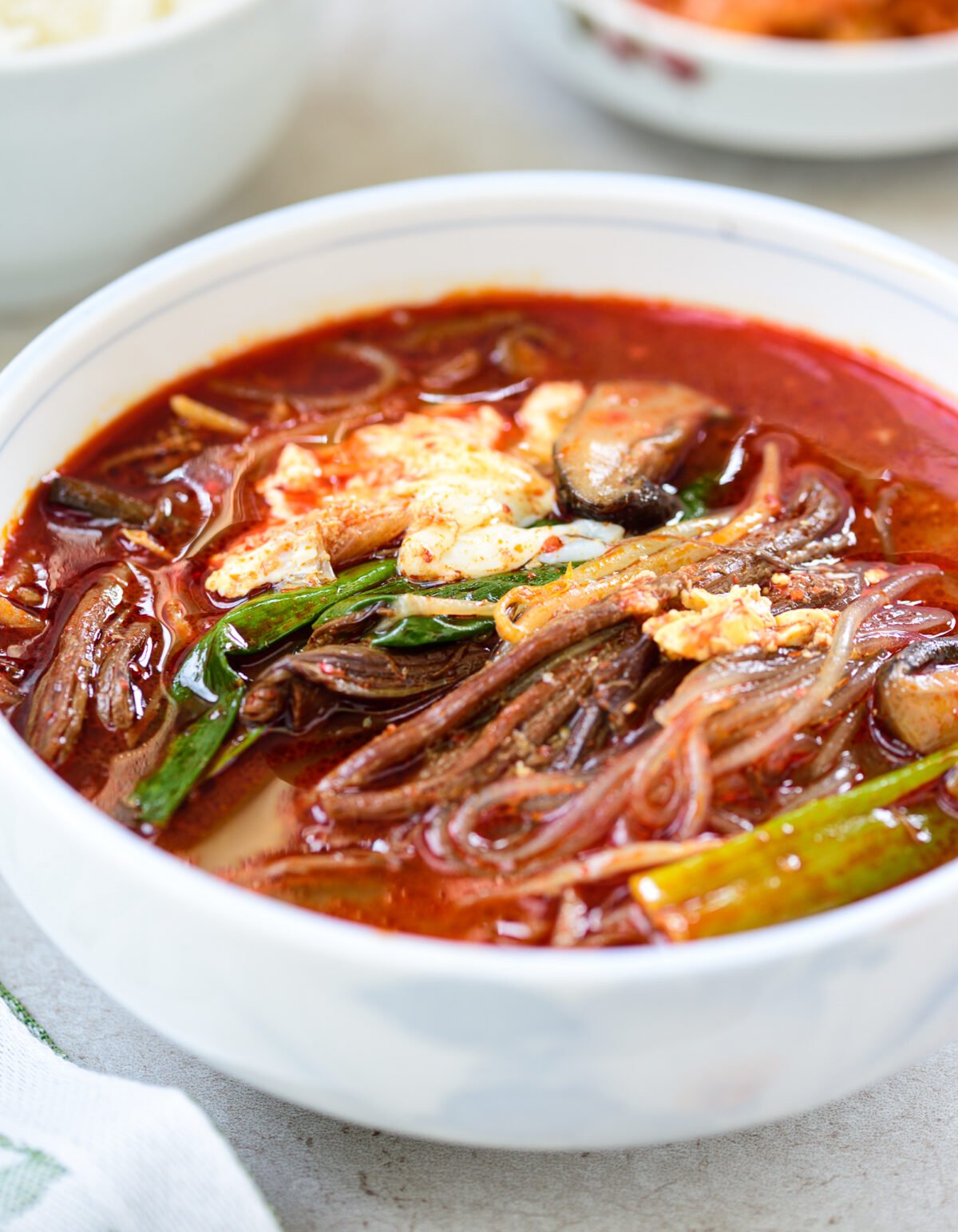
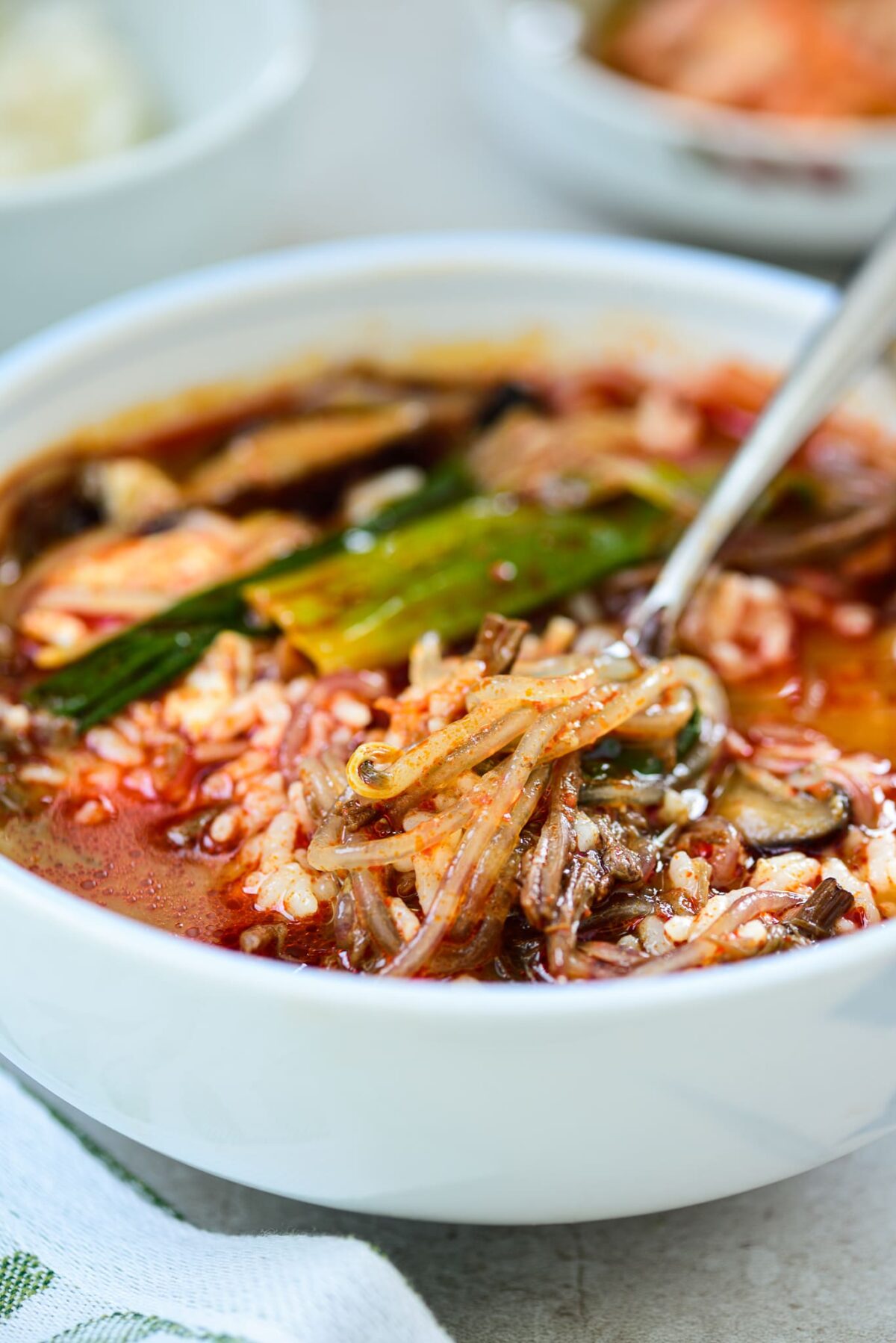
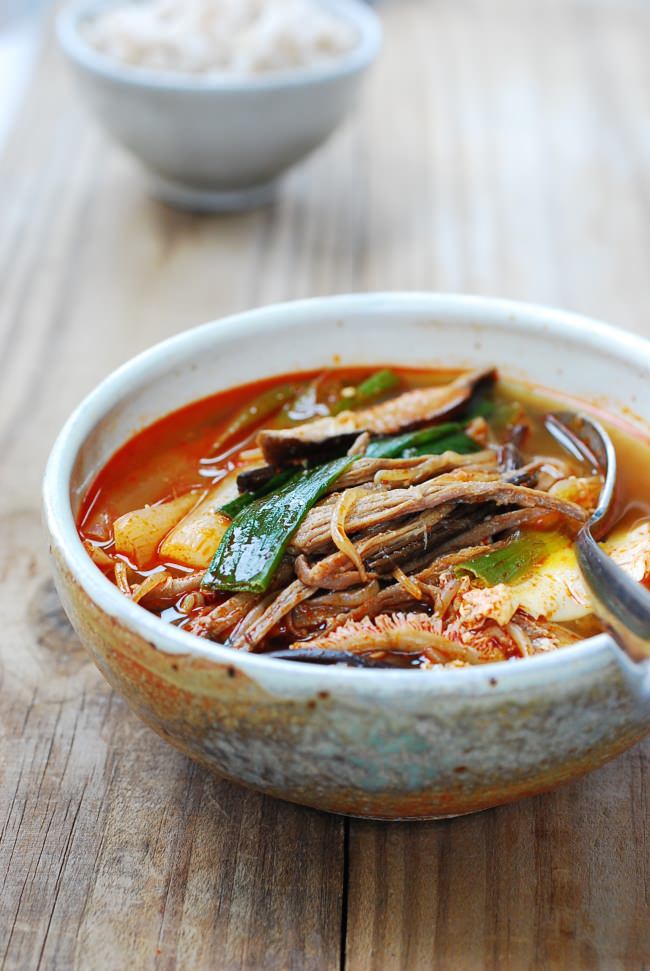
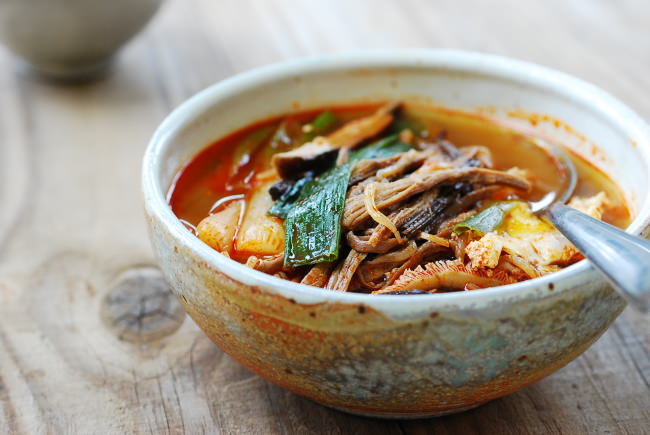
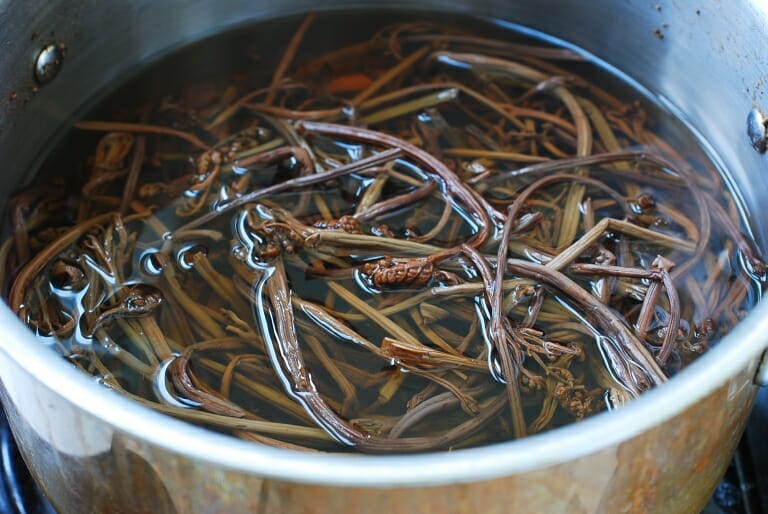
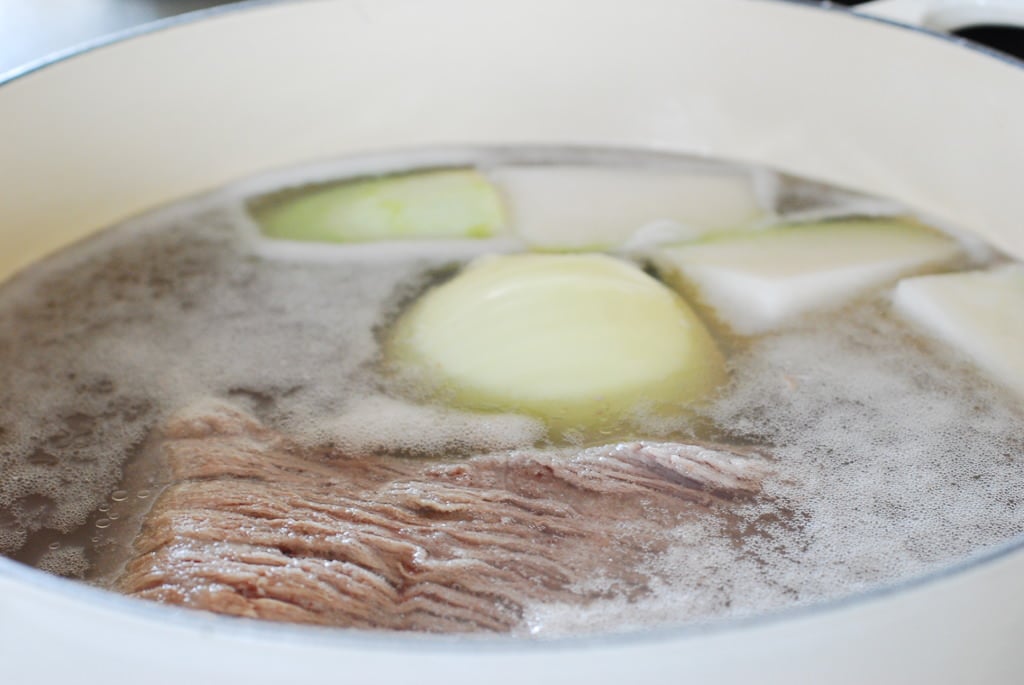
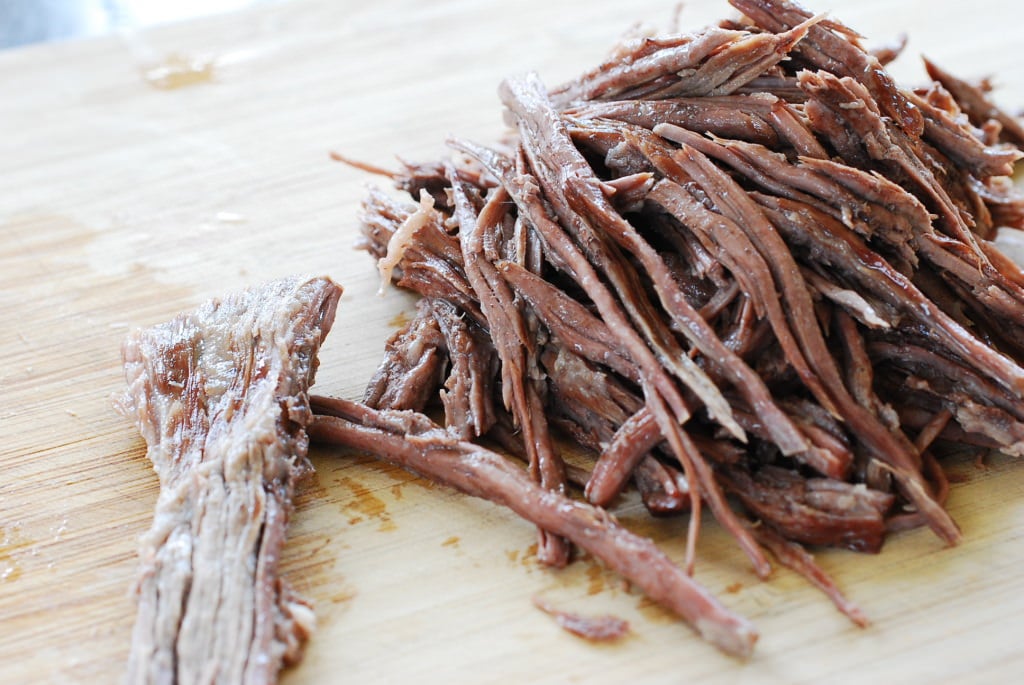
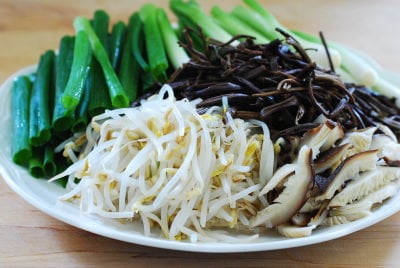
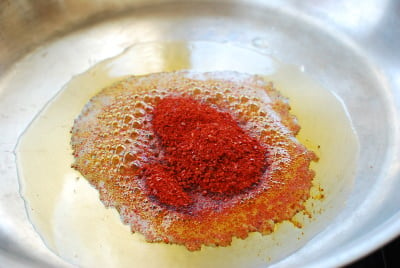
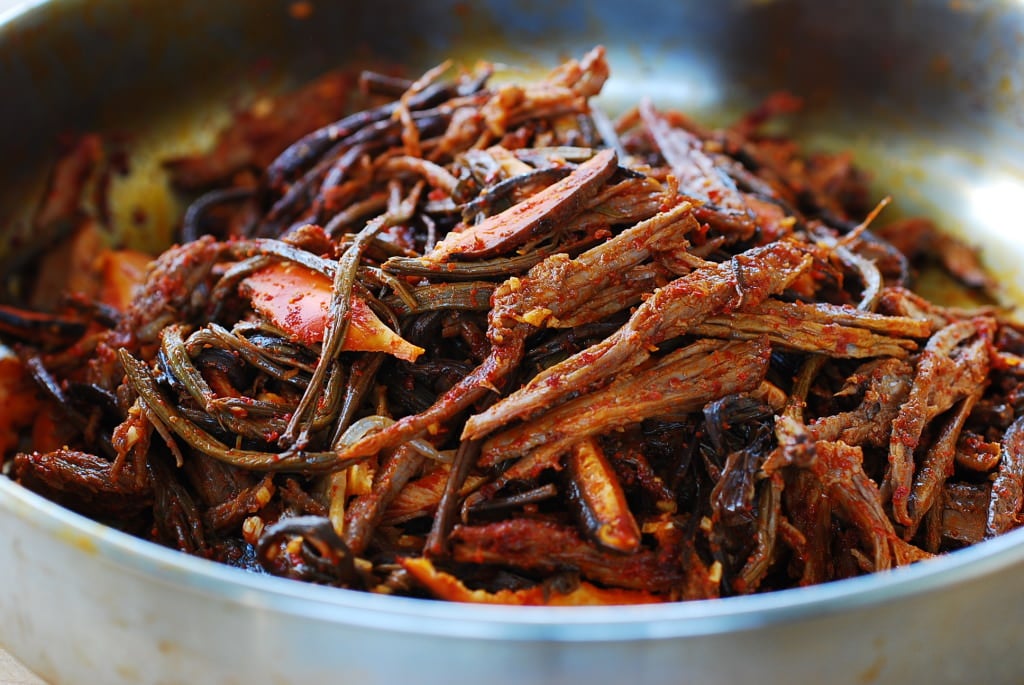
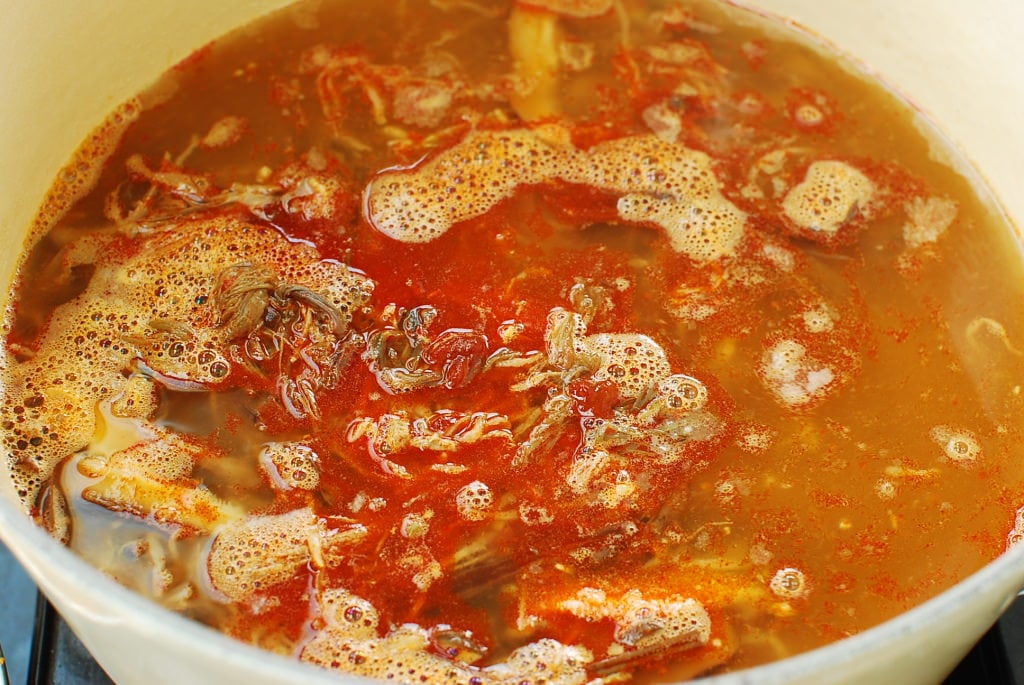
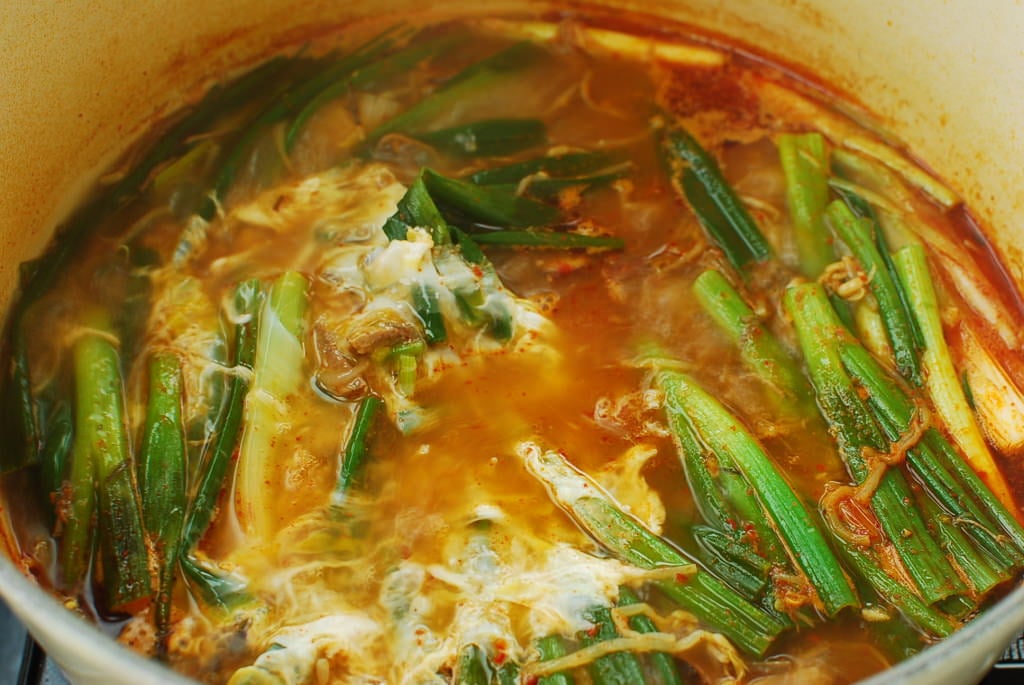
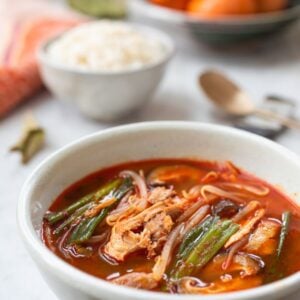
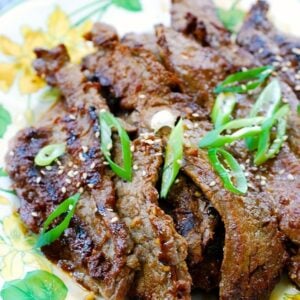
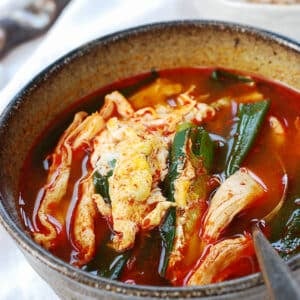
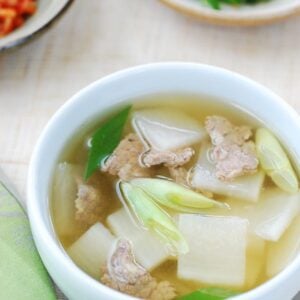













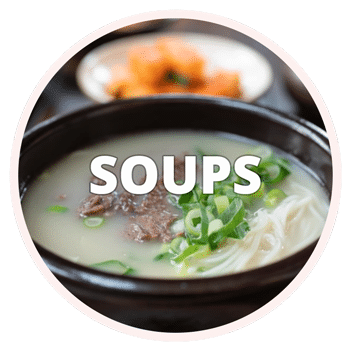
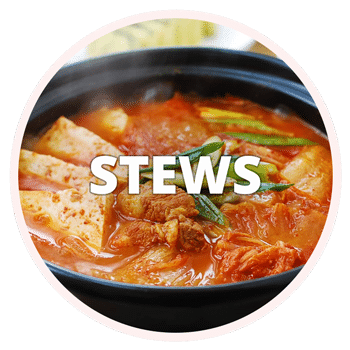


Lisa Marie Campbell says
First time making this dish. Easy ingredients. Came out delicious! 감사합니다
blanko says
i′ve made this a few times now without the gosari (quite hard to find in small-town germany 🥲) and it’s amazing―especially good for cold days and feeling under the weather, as i am today. quite the panacea. i never change a thing other than omitting the gosari, but i′m hoping my next trip to berlin will prove fruitful.
thanks so much! i use your recipes all the time for my husband, who spent a year abroad in seoul and rather misses the food.
Keri says
Hi! Love your recipes. I had a question, though. In the recipe part, you mention Garlic for the meat. You also separately mention garlic for the seasoning. But how much garlic goes into the meat broth? I can’t find that amount in the recipe. Thank you!
Hyosun says
Oh sorry about that! Actually you don’t need garlic for boiling the meat (step 2), and I have corrected the step. Thanks for letting me know.
min sook says
I tried this recipe and it was good but I think I made a mistake. When I went to the butcher in my neighbourhood, they gave me a cut of brisket that was VERY fatty. I boiled this and got oily broth and the spices seemed to cover up the oil. I thought it was just the particular cut I got. I tried the recipe again and again the cut of brisket was really fatty. It appears there are different brisket cuts depending on the butcher you go to? If I get brisket from the Korean grocery store it is lean. I used the fatty brisket from the non Korean butcher and it produced a broth that is very oily. I cannot always get to the Korean butcher as it is a bit of a trek. If I get the fatty brisket should I cut away all the fat? Or can I reduce the oily broth to make it better? I’m not very experienced at broth.
Hyosun says
Fatty brisket is flavorful. You can use a fat separator to remove the fat at the end or chill the broth until the fat solidifies and then remove. A fat separator is not expensive but quick and convenient to have it around. Hope this helps!
Derek K says
The shop owner where I purchased Gosari previously would put the Gosari in a pot, cover with water then add a tsp or so of Baking Soda. The Gosari softens quite nicely!
Stevie says
This is next on my list to try! Do you use a soup base?
Hyosun says
You can use it if you want to add more flavor, but not absolutely necessary.
Frederikke says
Can I make this without the gosari? I can’t find it in any Asian shops in my country.
Inae Hwang says
How would you modify the recipe if you can get fresh gosari?
Hyosun says
Fresh gosari should be boiled until tender, rinsed and soaked in water for a few hours before being used. This will remove the bitterness.
Arpita Patel says
Very good. I added green onions and a little bit of garlic powder so it was not too bland. I took the other reviewers suggestions on adding the cornstarch and thickening before adding the eggs. This was also good reheated.
Myung Armstrong says
Hi Hyosun! Hope you are well and staying safe from Covid. I love YukGaeJang! My all time favorite soup after seaweed soup and soybean sprout soup and………..hahahahaha! This looks like a recipe I can definitely make at home. Can I use Instapot to soften the Gosari? Soaking overnight and boiling didn’t work very well for me. Thank you for all your wonderful recipes. It inspires me to cook more Korean food. I used to get recipes from my mother but now she has passed away several years ago, I go to your site!
Myung
Hyosun says
Of course! You don’t really need to soak gosari overnight. They are pretty tender and rehydrated pretty quickly these days, although the required time varies quite a bit depending on gosari. Happy to hear my recipes inspire you to cook more Korean food! Thanks!
Dustin says
This one of my all time favourite soups. I make this when I really don’t want to be bothered. I let it boil and boil and do its favourful thing.
I think I will make some now.
Kim Luong says
I’ve seen many recipes for this soup and have to say it’s one of the simplest and most flavorful! I used extra gosari, as this is my husband’s favorite. I used a mix of soy sauce and fish sauce (nuc mam) for umami, which gives it an extra depth of flavor. Thanks for the wonderful recipe and look forward to more!
Kelly brown says
Followed the recipe! Was delicious. Only change I might do differently is to make beef bouillon and add flank steak later. The broth needs to be slightly richer. I would recommend this recipe to friends. Yum yum^^
Ellie says
This is such a great recipe! I was wondering if there a non spicy version of this soup? I would love to make a non spicy version of this for my children.
Hyosun says
Thank you! Just reduce or omit gochugaru for the kids.
Mathew says
Amazing. Second time I have cooked Yukgaejang with following your recipe.
My Korean friends really enjoyed it also
Hyosun says
That’s great to hear! Thanks for letting me know.
Juan says
Incredible. It tastes good and made me really really full.
Jane Bullard says
Thank you for another great recipe. Again, very authentic. I enjoy making my own Korean food, and I found your website and have been a loyal user. This recipe tastes very similar to the restaurant, but I can save alot of money by making it myself. Plus, I can have as much as I want !
Hyosun says
Oh thank you! Great to hear that! Happy Korean cooking!
Crystal H says
Hi I’ve tried making yukgaejang twice now and I feel like everytime its kind of watery. I wonder what the end resulting volume of liquid should from the original 14cups of water. Whenever I go to restaurants it tastes much richer/thicker(?). One restaurant’s description of their yukgaejang was “buttery without adding butter”. Some of my friends have suggested adding a bone in to give it a bit of a seollongtang thickness? What are your thoughts? Thanks for posting the recipe!!
Alex says
Yeah, I just made this and it’s watery. I had to add a lot of salt and some extra soup soy sauce. I think two things might help. One, if you’re using beef brisket for the broth, it needs to cook way longer than 1 to 1.5 hours. Brisket is such a tough piece of meat that it really needs to be cooked way longer. Instead of following time for the broth, just keep it at a medium simmer until the brisket is tender. I’m thinking maybe 4 hours for it to be tender to shred by hand. 1.5 hours, the brisket is impossible to shred without super strength. Adding a few beef bones as you suggested is also a good idea, but even with beef bones, you have to cook them a long time. Second, if you don’t have the time to boil the brisket for hours, reduce the cups of water in the recipe and add salt and adjust to taste. That’s what I did and it turned it fine.
Janne says
Initially had same issue but on second try used chuck beef (it shreds easier). I also added a tablespoon of both gochujang and duenjang which made the soup substantially more robust and similar to what you’d get at a Korean restaurant. I omitted the mushrooms and threw the radish back in (sliced) to stew together. Not sure if that contributed to deepening the flavor but overall result was delicious.
Myung Armstrong says
I would suggest using the “milky beef broth” you can buy at the Korean grocery store.Also use less water to boil the meat. Use Instapot or pressure cook the meat with less water. Hope this helps.
H.S. says
Hi, I love your website and would love to try this recipe. I am wondering what is soup soy sauce? Is it something that is already bottled and sold at the Korean market?
Hyosun says
Oh sorry I’ve missed your question. Yes it is. Called 국간장 or 조선 간장. See my ingredients tab at the top of the page for a photo.
Sook-Chung says
This one of my favourite soup my mom made for me when I was little. Thank you so much for sharing this recipe. I will make it for my mom now as she is elderly and does not remember how to.
Blessings and with much gratitude.
Sj
Hyosun says
Aww that’s nice! I’m sure your mom will love it, made with daughter’s love. It’s my great pleasure to share recipes. Hearing stories like yours makes it very rewarding.
Laura Young Han says
Thank you for sharing your precious recipes. I am giong to be a good cook soon!!
Jenna says
Hello, I love your blog! I’m making this recipe tomorrow with a friend for the first time and I’m really excited! Just one question: would you recommend adding noodles to this dish? If so, what type?
Hyosun says
Thanks for the love! Dangmyeon (Korean sweet potato starch noodles) is the best one to use. It’s the japchae noodle and also typically used for yukgaejang. Enjoy!
Mike Chunkerman says
I use my own recipe “inspired” by others and employing what I have in the cupboard and what veggies are fresh and well-priced at any given time. For example, I’ve used Napa and green cabbage, thinly sliced carrots, yellow and white onion, bell peppers, button mushrooms, kimchee, daikon radish, red radish, and bok choy. For noodles, which I always add to my soup, I have used the sweet potato starch variety, rice vermicelli, soba, and udon. All of them work well, and I find the udon noodles make a more substantial meal out of the soup. They might not be considered traditional, but they are very tasty in this application.
Myung Armstrong says
Your version sounds good too! FYI almost all Korean soup is served with rice. It is not a stand alone meal. Hope this helps to make it a filling meal.
Diego L says
I know this is going to sound ridiculous, but I’ve substituted fresh watercress for the kosari and it turned out surprisingly good. Watercress doesn’t need to be cooked for long, so I just add it at the very end with the scallions.
Young Mi says
Hi Hyosun, thank you for this recipe. I made it today n it’s a keeper. I was wondering if I can use the liquid that the 고사리 was soaking and cooking in to add to the soup stock? I’d still keep it 14 cups of water only minus and replace the 고사리 liquid however amount it measures to be. Would that make it too strong with that flavor, or bitter…? Hope my question isn’t confusing. Thanks again!
Hyosun says
Hi Young Mi – Thanks for trying the recipe out! Glad it’s a keeper for you. I think gosari soaked water would overpower the soup and make it bitter. You can use the mushroom soaked water if you want to add more flavor to the soup. Cheers!
Gina says
Oh my, I miss yukgaejang. When we lived in the NY country, my Mom and I would travel to the city once a month to go to the Korean stores and she would always order this at the restaurant there. So many memories, I am def. making this soon, thanks for the recipe <3
Gina
Pink Wings
Sophie says
Thank you so much for your website. I love your recipes !!! I would like to know if you are going to put a recipe about how to make 칼국수.
Thank you very much.
Hyosun says
You’re welcome, Sophie! Kalguksu is definitely on my to-do list. Stay tuned!
Maxwell says
My girlfriend just made this for my family and it’s wonderful! Thank you so much for the winter recipe
Hyosun says
That’s great to hear, Max! Hope you’re having a great holiday season with your family and friends.
Kim says
Hi. I have some dried gosari and would like to know how to use/season them as a side dish. I use your website ALL the time. Thank you.
Hyosun says
Kim – My bibimbap recipe includes a gosari side dish recipe. It’s obviously for bibimbap, but it can also be a side dish. Thank you so much for using my recipes!!
Melody says
U was wondering if using a pressure cooker would help to speed up the process without sacrificing quality?
Hyosun says
Hi Melody – So sorry for the late response. I haven’t used a pressure cooker to make this soup, but I’m sure it will help speed up the process. I’d recommend using the pressure cooker for only step 2 though. Enjoy!
Catherine Barrientos says
Huh! I actually do use the pressure rice cooker when I’m running late. Hehe!